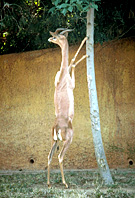| The Value of Species |
 Direct
Values Direct
ValuesIndirect Values The reasons for preventing losses of species, and maintaining ecosystems and biodiversity, are many and wide-ranging: the social, ethical, aesthetic and cultural values of plants and animals have been recognised in religion, art, and literature throughout history. For many people, the value of biological diversity is self-evident, and to attempt to quantify that value only demeans it. However, some nature conservation groups argue that it is necessary to demonstrate the economic worth of biodiversity so as to influence decision-makers and to compete with those offering economic benefits from the exploitation of biological resources. The reasons for preventing losses of species, and maintaining ecosystems and biodiversity, are many and wide-ranging: the social, ethical, aesthetic and cultural values of plants and animals have been recognised in religion, art, and literature throughout history. For many people, the value of biological diversity is self-evident, and to attempt to quantify that value only demeans it. However, some nature conservation groups argue that it is necessary to demonstrate the economic worth of biodiversity so as to influence decision-makers and to compete with those offering economic benefits from the exploitation of biological resources. This is the value of products that are bought and sold on the market, such as timber, fish, animal skins, fruits, etc. Usually, these values are the only ones that count as part of GNP; and then only when they are removed from the ecosystem. Additionally, wild species contribute to the production of food and other goods in indirect ways by improving existing varieties or by providing the source of genes for breeding new varieties. They are also useful as forage for livestock production, as pollinators for crops, and as predators for crop pests. In a 1986 study, Prescott-Allen and Prescott-Allen estimated that wild species of plants and animals have made a contribution to the value of 4.5 per cent of GDP in the USA and a much higher percentage in developing countries. This refers to products that are used by people but are not bought or sold on the market. This might include firewood or food collected in a forest but not paid for. Such values are not included in measures of GNP but they are not insignificant. It is estimated that wildlife-related recreational activities provide Canadians with $800 million of benefits every year, and that firewood and dung provide more than 90 per cent of primary energy needs in Nepal, Tanzania and Malawi. These values could be assigned a monetary value by estimating how much these goods would cost on the market. Plants and animals can also be useful without being used up or consumed; for example, for scientific research or bird-watching or bush-walking. Perhaps more importantly, biological resources perform environmental services which are essential for the healthy functioning of an ecosystem. Non-consumptive benefits might include:
This is the value of keeping species or ecosystems in case they might be useful in the future. Most species on the planet have not been identified or characterised by scientists. Since a few known species have provided so many products that are beneficial, it is reasonable to assume that some of the unknown ones might do so in the future. Also, because technology and scientific knowledge is constantly changing, it is also probable that known species might provide uses that have not yet been thought of. Moreover, since the future is uncertain, it is better to keep our options open: we do not know now what we might need later. 'The best preparation in the context of wildlife use is to have a safety net of diversity.' Another future dimension of value to consider is that demand for natural resources is likely to grow as species become extinct or rare. This will ensure that their value increases due to scarcity. This category recognises that people place a value on the existence of a species or ecosystems even if they have no use for it themselves and may never even visit it. They just like to know that it is there. It has been suggested that whilst it would be impossible to measure this value accurately, contributions to conservation groups who aim to preserve such species or ecosystems may be an indicator of concern.
Source: McNeely et al, 1990. |
© 2001 Sharon Beder
